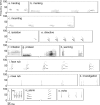Syllable acoustics, temporal patterns, and call composition vary with behavioral context in Mexican free-tailed bats
- PMID: 19045674
- PMCID: PMC2676615
- DOI: 10.1121/1.2953314
Syllable acoustics, temporal patterns, and call composition vary with behavioral context in Mexican free-tailed bats
Abstract
Recent research has shown that some bat species have rich vocal repertoires with diverse syllable acoustics. Few studies, however, have compared vocalizations across different behavioral contexts or examined the temporal emission patterns of vocalizations. In this paper, a comprehensive examination of the vocal repertoire of Mexican free-tailed bats, T. brasiliensis, is presented. Syllable acoustics and temporal emission patterns for 16 types of vocalizations including courtship song revealed three main findings. First, although in some cases syllables are unique to specific calls, other syllables are shared among different calls. Second, entire calls associated with one behavior can be embedded into more complex vocalizations used in entirely different behavioral contexts. Third, when different calls are composed of similar syllables, distinctive temporal emission patterns may facilitate call recognition. These results indicate that syllable acoustics alone do not likely provide enough information for call recognition; rather, the acoustic context and temporal emission patterns of vocalizations may affect meaning.
Figures





References
-
- Altringham, J. D., and Fenton, M. B. (2003). “Sensory ecology and communication in the chiroptera,” in Bat Ecology, edited by Kunz T. H. and Fenton M. B. (The University of Chicago Press, Chicago, IL: ), pp. 90–127.
-
- Arnold, K., and Zuberbühler, K. (2006a). “The alarm-calling system of adult male putty-nosed monkeys, Cercopithecus nictitans martini,” Anim. Behav. 72, 643–653.
-
- Balcombe, J. P. (1990). “Vocal recognition of pups by mother Mexican free-tailed bats, Tadarida brasiliensis mexicana,” Anim. Behav. 10.1016/S0003-3472(05)80961-3 39, 960–966. - DOI
-
- Balcombe, J. P., and McCracken, G. F. (1992). “Vocal recognition in Mexican free-tailed bats—do pups recognize mothers?,” Anim. Behav. 10.1016/S0003-3472(05)80073-9 43, 79–87. - DOI
Publication types
MeSH terms
Grants and funding
LinkOut - more resources
Full Text Sources
Miscellaneous

